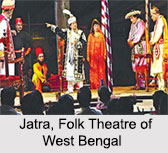 Folk Theatre of West Bengal is an important indigenous tool of interpersonal communication which reflects the social-political realities of its time. In Bengal, folk theatre is considered an art form that keeps the basic elements of a drama intact, while taking on the stories and flavours of the region its stems from. This very aspect makes folk theatre a vibrant and vital aspect of India"s intangible cultural heritage.
Folk Theatre of West Bengal is an important indigenous tool of interpersonal communication which reflects the social-political realities of its time. In Bengal, folk theatre is considered an art form that keeps the basic elements of a drama intact, while taking on the stories and flavours of the region its stems from. This very aspect makes folk theatre a vibrant and vital aspect of India"s intangible cultural heritage.
History of Folk Theatre of West Bengal
India has a long, rich and illustrious history of folk theatre. In ancient times, Sanskrit dramas were staged at seasonal festivals or to celebrate special events. Infusion of local myths, costumes and masks into the ancient form of drama, resulted in the evolution of diverse regional styles of folk theatre. Rabindranath Tagore"s plays reflect the influence of Baul singers and folk theatre too.
While some folk theatre forms like Raslila, Nautanki and Ramlila are recognized all over the country, there are some folk theatres of West Bengal which, in spite of being equally amazing, remain largely unnoticed.
Jatra: The Jatra, also popular in Odisha and eastern Bihar, originated in Bengal in the 15th century as a result of the Bhakti movement. It was initially known as "Krishna Jatra" due to Shri Chaitanya"s (spiritual founder of Gaudiya Vaishnavism) influence. While initially this theatre was primarily musical, today, jatra performances consists mainly of action-packed dialogues with few songs.
This article is a stub. You can enrich by adding more information to it. Send your Write Up to content@indianetzone.com




